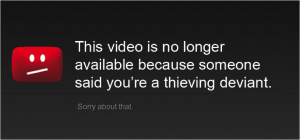We bring you a guest post from Shashank Singh, a 2nd year student from NUJS. In this post, he looks at Youtube’s new “Content ID” mechanism of checking videos for copyright infringement. This is Shashank’s first entry to our 2nd Annual SpicyIP Fellowship applicant series.
Gamers Beware! Youtube’s introduces ‘Content ID’ to enforce copyright policy.
Statistics reveal that over 100 hours of video are uploaded on Youtube every minute. For generating content, Youtube incentivises uploading videos by monetizing the video through advertisements. The advertisements at the beginning, middle or/and end of the video is the discretion of the ‘channel owner’ (the person publishing the video). Considering such large amount of data is uploaded every day, the “due diligence” for checking copyright infringement is a tedious task. For instance, in some videos while the bare video is original, the use of copyrighted music in the background may be an infringement, and vice-versa.
Being an intermediary Youtube has an elaborate copyright infringement notification mechanism and offers the owners three choices when they report a copyright infringement:
i) Block– Under this, the owner again has three options.
a) to completely block the video.
b) to block the infringed part e.g. muting the audio.
c) to selectively block the video in specific regions.
ii) Monetize– the owner can monetize the video and for future distribution of revenue the revenue shall be diverted to him. Also, if the video has not been monetized yet, the owner can choose to play advertisements depending on the policy adopted.
iii)Track– The content owner can track the viewership statistics.
Further, this policy can be adopted selectively depending on the region. Thus, a video may be blocked in one region, tracked in another and monetized in the third.
All this is done through a programme called Content ID. The programme allows copyright owners to scan the Youtube database for infringements. Once the programme identifies a match it applies the policy chosen by the content owner (as stated above). The Youtuber can then send counter notification in order to reinstate the video if removal was due to some mistake or misidentification. However, the system works on a -‘guilty until proven innocent’ premise. Thus, initially the policy adopted by the owner is chosen, and only after the elaborate counter notification mechanism absolves the Youtuber, that the video is reinstated.
The recent crackdown on gaming videos
Gamers, are the first group of ‘Youtubers’ to be on the receiving end of this new enforcement policy. Youtube has issued widespread copyright infringement notices to gamers uploading ‘game-walk throughs’ and ‘Let’s Play’ videos and tutorials. These videos are essentially review videos, wherein the gamers talk about the game, point out discrepancies, show the best ways to clear a level in the game, display tricks within the game etc. These videos are generally encouraged by the copyright owners as it amount to free publicity.
The enforcement of this policy led to angry Youtubers demanding a reversal of the arbitrary policy because random companies that had absolutely no claim on the copyright had monetized the video. This was also backed by many companies that own the original copyright stating that they never reported or even intended to enforce their copyright. Youtube on its part issued a statement justifying its new policy and offered tips on how to upload videos without copyright infringement. (Full statement by Youtube can be accessed here)
Fair Use (Indian context)
The website states that doctrine of fair use shall be applied keeping in mind the particular jurisdiction. It states that in US the copyright is limited by the doctrine of fair use and “criticism, commentary, news reporting, teaching, scholarship, or research may be considered fair use”.
Similarly, India too has adopted this doctrine under §52, Copyright Act. The computer games would come under the category of ‘literary work’ under §2(o), Copyright Act. Further, being an intermediary, Youtube would be governed under Information Technology (Intermediaries Guidelines) Rules 2011 issued under Information Technology Act, 2000. This obligates them under §3(2) (d) to observe due diligence on material that “infringes any patent, trademark, copyright or other proprietary rights”. Consequently, this might be a reason for such crackdown.
Judicial intervention in this case seems highly unlikely because of the unorganised gamers. However, in future if such a situation does arise, in my opinion this case would tilt towards the gamers. This is because, firstly, fair criticism can be allowed to the extent that the person does not intent to draw any monetary benefit from the same. This obviously applies to the videos that have not been monetized. Secondly, the copyright owners in many cases never wanted the videos to be taken down.
Censorship Issue
Being an intermediary in the changing technological landscape, Youtube has, in light of multi-million dollar claims, tried to effectively check copyright infringement. However, there is another angle to the entire scenario, outside the domain of copyright law, though supported by it. These gamers review various games and publish their views through these videos. These videos often criticize the game, thus, influencing the market for such games. It is important to note that buyers often consult these videos before buying the original games. What this new programme, Content ID, does is that it leaves it open for the copyright owner to selectively block the video. Thus, in the name of copyright infringement the owner can clamp on free speech by censoring the videos that contain critical comments.
A final caveat: It is still not clear whether the gaming companies requested the take down or whether it was a suo moto action on part of Youtube.

